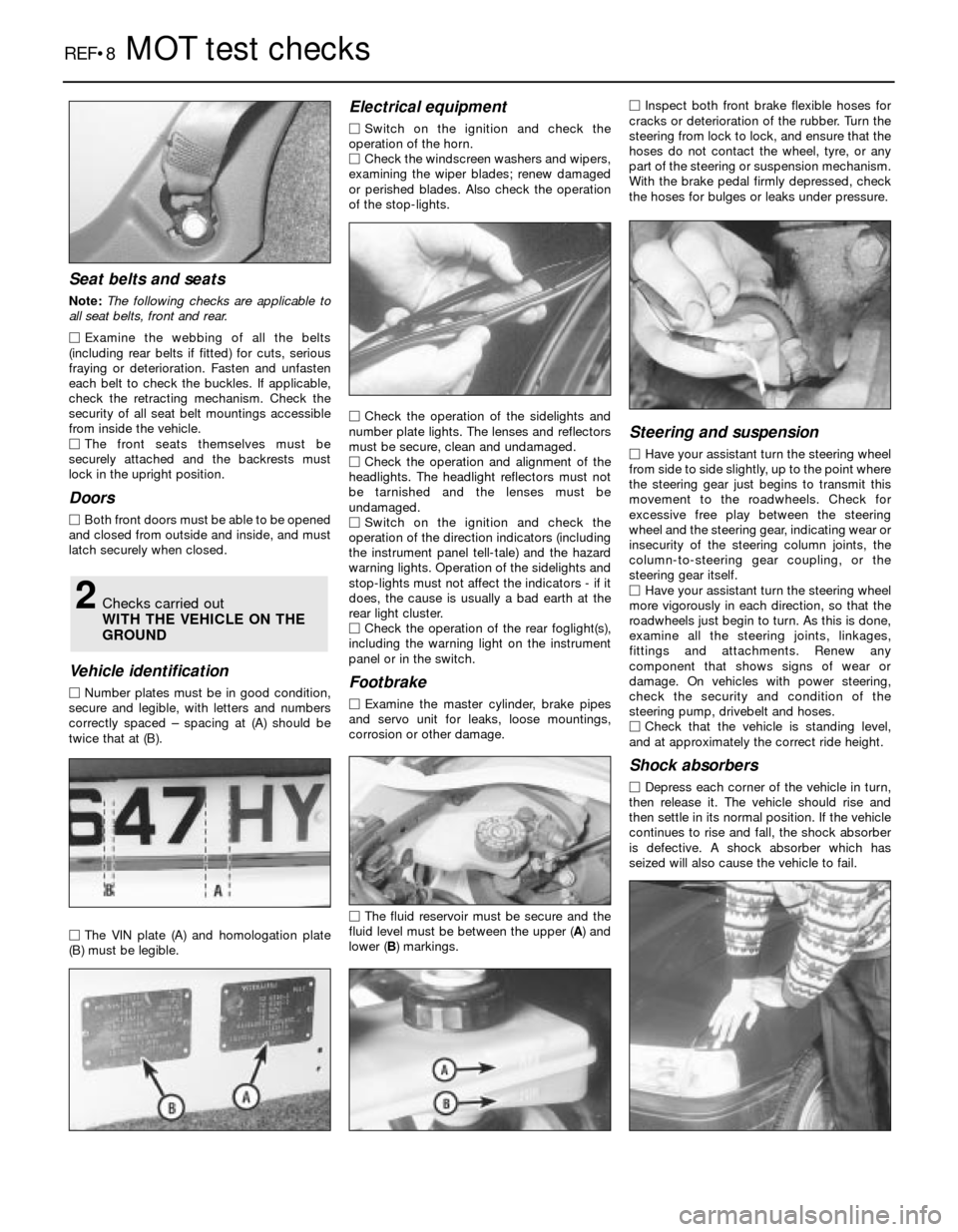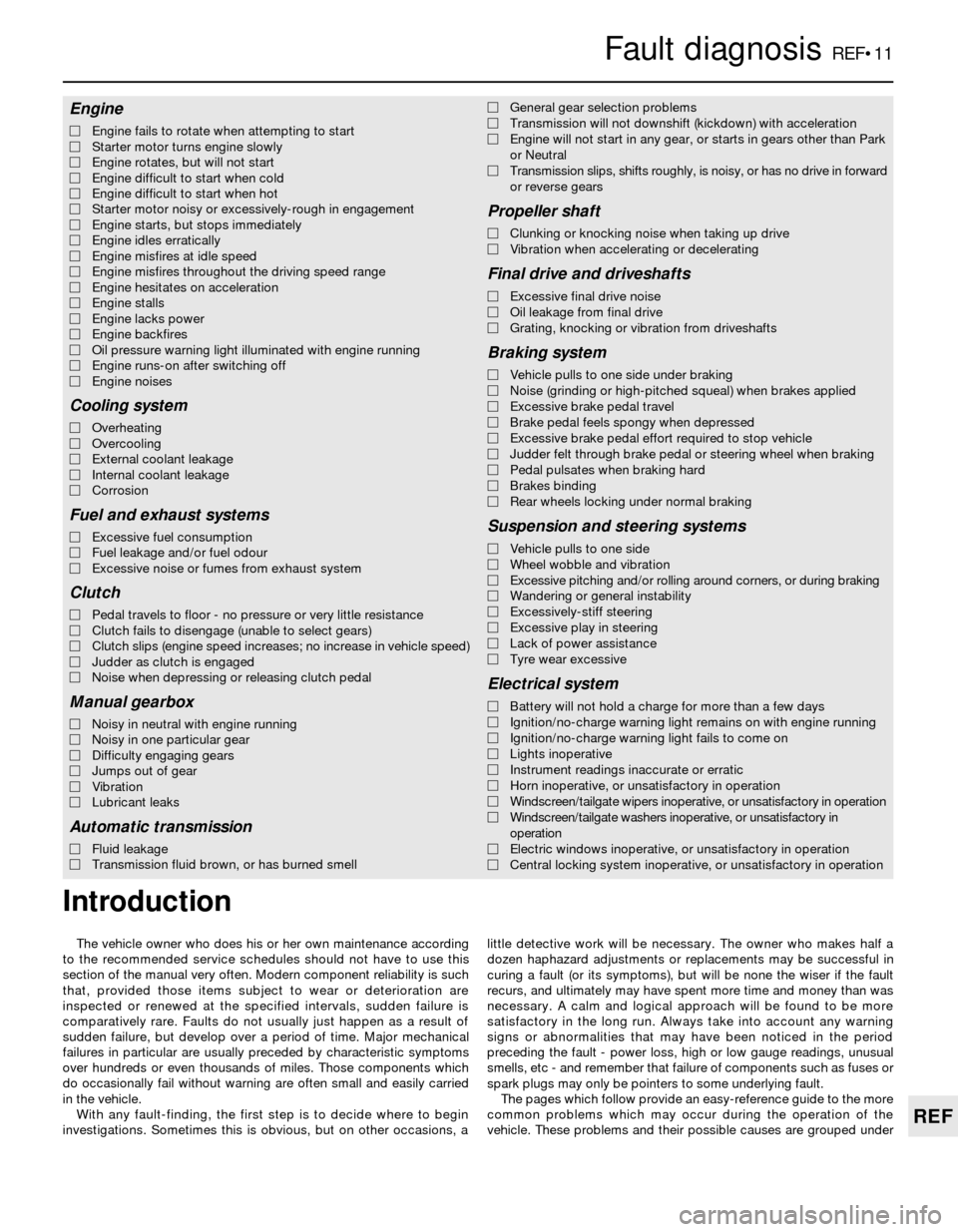warning FORD SIERRA 1983 1.G Reference Workshop Manual
[x] Cancel search | Manufacturer: FORD, Model Year: 1983, Model line: SIERRA, Model: FORD SIERRA 1983 1.GPages: 26, PDF Size: 0.57 MB
Page 8 of 26

REF•8MOTtest checks
Seat belts and seats
Note: The following checks are applicable to
all seat belts, front and rear.
MExamine the webbing of all the belts
(including rear belts if fitted) for cuts, serious
fraying or deterioration. Fasten and unfasten
each belt to check the buckles. If applicable,
check the retracting mechanism. Check the
security of all seat belt mountings accessible
from inside the vehicle.
MThe front seats themselves must be
securely attached and the backrests must
lock in the upright position.
Doors
MBoth front doors must be able to be opened
and closed from outside and inside, and must
latch securely when closed.
Vehicle identification
MNumber plates must be in good condition,
secure and legible, with letters and numbers
correctly spaced – spacing at (A) should be
twice that at (B).
MThe VIN plate (A) and homologation plate
(B) must be legible.
Electrical equipment
MSwitch on the ignition and check the
operation of the horn.
MCheck the windscreen washers and wipers,
examining the wiper blades; renew damaged
or perished blades. Also check the operation
of the stop-lights.
MCheck the operation of the sidelights and
number plate lights. The lenses and reflectors
must be secure, clean and undamaged.
MCheck the operation and alignment of the
headlights. The headlight reflectors must not
be tarnished and the lenses must be
undamaged.
MSwitch on the ignition and check the
operation of the direction indicators (including
the instrument panel tell-tale) and the hazard
warning lights. Operation of the sidelights and
stop-lights must not affect the indicators - if it
does, the cause is usually a bad earth at the
rear light cluster.
MCheck the operation of the rear foglight(s),
including the warning light on the instrument
panel or in the switch.
Footbrake
MExamine the master cylinder, brake pipes
and servo unit for leaks, loose mountings,
corrosion or other damage.
MThe fluid reservoir must be secure and the
fluid level must be between the upper (A) and
lower (B) markings.MInspect both front brake flexible hoses for
cracks or deterioration of the rubber. Turn the
steering from lock to lock, and ensure that the
hoses do not contact the wheel, tyre, or any
part of the steering or suspension mechanism.
With the brake pedal firmly depressed, check
the hoses for bulges or leaks under pressure.
Steering and suspension
MHave your assistant turn the steering wheel
from side to side slightly, up to the point where
the steering gear just begins to transmit this
movement to the roadwheels. Check for
excessive free play between the steering
wheel and the steering gear, indicating wear or
insecurity of the steering column joints, the
column-to-steering gear coupling, or the
steering gear itself.
MHave your assistant turn the steering wheel
more vigorously in each direction, so that the
roadwheels just begin to turn. As this is done,
examine all the steering joints, linkages,
fittings and attachments. Renew any
component that shows signs of wear or
damage. On vehicles with power steering,
check the security and condition of the
steering pump, drivebelt and hoses.
MCheck that the vehicle is standing level,
and at approximately the correct ride height.
Shock absorbers
MDepress each corner of the vehicle in turn,
then release it. The vehicle should rise and
then settle in its normal position. If the vehicle
continues to rise and fall, the shock absorber
is defective. A shock absorber which has
seized will also cause the vehicle to fail.
2Checks carried out
WITH THE VEHICLE ON THE
GROUND
Page 11 of 26

The vehicle owner who does his or her own maintenance according
to the recommended service schedules should not have to use this
section of the manual very often. Modern component reliability is such
that, provided those items subject to wear or deterioration are
inspected or renewed at the specified intervals, sudden failure is
comparatively rare. Faults do not usually just happen as a result of
sudden failure, but develop over a period of time. Major mechanical
failures in particular are usually preceded by characteristic symptoms
over hundreds or even thousands of miles. Those components which
do occasionally fail without warning are often small and easily carried
in the vehicle.
With any fault-finding, the first step is to decide where to begin
investigations. Sometimes this is obvious, but on other occasions, alittle detective work will be necessary. The owner who makes half a
dozen haphazard adjustments or replacements may be successful in
curing a fault (or its symptoms), but will be none the wiser if the fault
recurs, and ultimately may have spent more time and money than was
necessary. A calm and logical approach will be found to be more
satisfactory in the long run. Always take into account any warning
signs or abnormalities that may have been noticed in the period
preceding the fault - power loss, high or low gauge readings, unusual
smells, etc - and remember that failure of components such as fuses or
spark plugs may only be pointers to some underlying fault.
The pages which follow provide an easy-reference guide to the more
common problems which may occur during the operation of the
vehicle. These problems and their possible causes are grouped under
Fault diagnosisREF•11
REF
Engine
MEngine fails to rotate when attempting to start
MStarter motor turns engine slowly
MEngine rotates, but will not start
MEngine difficult to start when cold
MEngine difficult to start when hot
MStarter motor noisy or excessively-rough in engagement
MEngine starts, but stops immediately
MEngine idles erratically
MEngine misfires at idle speed
MEngine misfires throughout the driving speed range
MEngine hesitates on acceleration
MEngine stalls
MEngine lacks power
MEngine backfires
MOil pressure warning light illuminated with engine running
MEngine runs-on after switching off
MEngine noises
Cooling system
MOverheating
MOvercooling
MExternal coolant leakage
MInternal coolant leakage
MCorrosion
Fuel and exhaust systems
MExcessive fuel consumption
MFuel leakage and/or fuel odour
MExcessive noise or fumes from exhaust system
Clutch
MPedal travels to floor - no pressure or very little resistance
MClutch fails to disengage (unable to select gears)
MClutch slips (engine speed increases; no increase in vehicle speed)
MJudder as clutch is engaged
MNoise when depressing or releasing clutch pedal
Manual gearbox
MNoisy in neutral with engine running
MNoisy in one particular gear
MDifficulty engaging gears
MJumps out of gear
MVibration
MLubricant leaks
Automatic transmission
MFluid leakage
MTransmission fluid brown, or has burned smellMGeneral gear selection problems
MTransmission will not downshift (kickdown) with acceleration
MEngine will not start in any gear, or starts in gears other than Park
or Neutral
MTransmission slips, shifts roughly, is noisy, or has no drive in forward
or reverse gears
Propeller shaft
MClunking or knocking noise when taking up drive
MVibration when accelerating or decelerating
Final drive and driveshafts
MExcessive final drive noise
MOil leakage from final drive
MGrating, knocking or vibration from driveshafts
Braking system
MVehicle pulls to one side under braking
MNoise (grinding or high-pitched squeal) when brakes applied
MExcessive brake pedal travel
MBrake pedal feels spongy when depressed
MExcessive brake pedal effort required to stop vehicle
MJudder felt through brake pedal or steering wheel when braking
MPedal pulsates when braking hard
MBrakes binding
MRear wheels locking under normal braking
Suspension and steering systems
MVehicle pulls to one side
MWheel wobble and vibration
MExcessive pitching and/or rolling around corners, or during braking
MWandering or general instability
MExcessively-stiff steering
MExcessive play in steering
MLack of power assistance
MTyre wear excessive
Electrical system
MBattery will not hold a charge for more than a few days
MIgnition/no-charge warning light remains on with engine running
MIgnition/no-charge warning light fails to come on
MLights inoperative
MInstrument readings inaccurate or erratic
MHorn inoperative, or unsatisfactory in operation
MWindscreen/tailgate wipers inoperative, or unsatisfactory in operation
MWindscreen/tailgate washers inoperative, or unsatisfactory in
operation
MElectric windows inoperative, or unsatisfactory in operation
MCentral locking system inoperative, or unsatisfactory in operation
Introduction
Page 13 of 26

MFuel filter choked (Chapter 1).
MFuel pump faulty, or delivery pressure low (Chapter 4).
MFuel tank vent blocked, or fuel pipes restricted (Chapter 4).
MFuel injection system fault (Chapter 4).
Engine lacks power
MFuel filter choked (Chapter 1).
MFuel pump faulty, or delivery pressure low (Chapter 4).
MUneven or low cylinder compressions (Chapter 2).
MWorn, faulty or incorrectly-gapped spark plugs (Chapter 1).
MVacuum leak at the throttle body, inlet manifold or associated
hoses (Chapter 4).
MFuel injection system fault (Chapter 4).
MBrakes binding (Chapters 1 and 10).
MClutch slipping (Chapter 6).
Engine backfires
MVacuum leak at the throttle body, inlet manifold or associated
hoses (Chapter 4).
MFuel injection system fault (Chapter 4).
Oil pressure warning light illuminated with engine
running
MLow oil level, or incorrect oil grade (Chapter 1).
MFaulty oil pressure sensor (Chapter 2).
MWorn engine bearings and/or oil pump (Chapter 2).
MExcessively high engine operating temperature (Chapter 3).
MOil pressure relief valve defective (Chapter 2).
MOil pick-up strainer clogged (Chapter 2).
Note:Low oil pressure in a high-mileage engine at tickover is not
necessarily a cause for concern. Sudden pressure loss at speed is far
more significant. In any event, check the gauge or warning light sender
before condemning the engine.
Engine runs-on after switching off
MExcessive carbon build-up in engine (Chapter 2).
MExcessively high engine operating temperature (Chapter 3).
Engine noises
Pre-ignition (pinking) or knocking during acceleration or
under load
MIgnition timing incorrect/ignition system fault (Chapters 1 and 5).
MIncorrect grade of spark plug (Chapter 1).
MIncorrect grade of fuel (Chapter 1).
MVacuum leak at throttle body, inlet manifold or associated hoses
(Chapter 4).
MExcessive carbon build-up in engine (Chapter 2).
MFuel injection system fault (Chapter 4).
Whistling or wheezing noises
MLeaking inlet manifold or throttle body gasket (Chapter 4).
MLeaking exhaust manifold gasket (Chapter 4).
MLeaking vacuum hose (Chapters 4 and 10).
MBlowing cylinder head gasket (Chapter 2).
Tapping or rattling noises
MWorn valve gear, timing chain, camshaft or hydraulic tappets
(Chapter 2).
MAncillary component fault (water pump, alternator, etc) (Chapters 3, 5)
Knocking or thumping noises
MWorn big-end bearings (regular heavy knocking, perhaps less
under load) (Chapter 2).
MWorn main bearings (rumbling and knocking, perhaps worsening
under load) (Chapter 2).
MPiston slap (most noticeable when cold) (Chapter 2).
MAncillary component fault (water pump, alternator, etc) (Chapters 3, 5)
Overheating
MAuxiliary drivebelt broken or incorrectly adjusted (Chapter 1).
MInsufficient coolant in system (Chapter 1).
MThermostat faulty (Chapter 3).
MRadiator core blocked, or grille restricted (Chapter 3).
MElectric cooling fan or thermostatic switch faulty (Chapter 3).
MViscous-coupled fan faulty (Chapter 3).
MIgnition timing incorrect, or ignition system fault (Chapters 1 and 5).
MInaccurate temperature gauge sender unit (Chapter 3).
MAirlock in cooling system (Chapter 3).
Overcooling
MThermostat faulty (Chapter 3).
MInaccurate temperature gauge sender unit (Chapter 3).
External coolant leakage
MDeteriorated or damaged hoses or hose clips (Chapter 1).
MRadiator core or heater matrix leaking (Chapter 3).
MPressure cap faulty (Chapter 3).
MWater pump internal seal leaking (Chapter 3).
MWater pump-to-block seal leaking (Chapter 3).
MBoiling due to overheating (Chapter 3).
MCore plug leaking (Chapter 2).
Internal coolant leakage
MLeaking cylinder head gasket (Chapter 2).
MCracked cylinder head or cylinder block (Chapter 2).
Corrosion
MInfrequent draining and flushing (Chapter 1).
MIncorrect coolant mixture or inappropriate coolant type (Chapter 1).
Fault diagnosisREF•13
REF
Cooling system
Excessive fuel consumption
MAir filter element dirty or clogged (Chapter 1).
MFuel injection system fault (Chapter 4).
MIgnition timing incorrect or ignition system fault (Chapters 1 and 5).
MBrakes binding (Chapter 10).
MTyres under-inflated (Chapter 1).
Fuel leakage and/or fuel odour
MDamaged fuel tank, pipes or connections (Chapters 1 and 4).
Excessive noise or fumes from exhaust system
MLeaking exhaust system or manifold joints (Chapters 1 and 4).
MLeaking, corroded or damaged silencers or pipe (Chapters 1 and 4).
MBroken mountings causing body or suspension contact (Chapter 4).
Fuel and exhaust systems
Page 16 of 26

Brakes binding
MSeized brake caliper piston(s) (Chapter 10).
MIncorrectly-adjusted handbrake mechanism (Chapter 10).
MFaulty master cylinder (Chapter 10).
Rear wheels locking under normal braking
MSeized brake caliper piston(s) (Chapter 10).
MFaulty brake pressure regulator (Chapter 10).
Note:For problems associated with the starting system, refer to the
faults listed under “Engine” earlier in this Section.
Battery will not hold a charge for more than a few
days
MBattery defective internally (Chapter 5).
MBattery electrolyte level low - where applicable (Chapter 1).
MBattery terminal connections loose or corroded (Chapter 1).
MAuxiliary drivebelt worn - or incorrectly adjusted (Chapter 1).
MAlternator not charging at correct output (Chapter 5).MAlternator or voltage regulator faulty (Chapter 5).
MShort-circuit causing continual battery drain (Chapters 5 and 13).
Ignition/no-charge warning light remains illuminated
with engine running
MAuxiliary drivebelt broken, worn, or incorrectly adjusted (Chapter 1).
MAlternator brushes worn, sticking, or dirty (Chapter 5).
MAlternator brush springs weak or broken (Chapter 5).
MInternal fault in alternator or voltage regulator (Chapter 5).
MBroken, disconnected, or loose wiring in charging circuit (Chapter 5). Note:Before diagnosing suspension or steering faults, be sure that the
trouble is not due to incorrect tyre pressures, mixtures of tyre types, or
binding brakes.
Vehicle pulls to one side
MDefective tyre (Chapter 1).
MExcessive wear in suspension or steering components (Chapters 1
and 11).
MIncorrect front wheel alignment (Chapter 11).
MAccident damage to steering or suspension components (Chapters 1
and 11).
Wheel wobble and vibration
MFront roadwheels out of balance (vibration felt mainly through the
steering wheel) (Chapter 11).
MRear roadwheels out of balance (vibration felt throughout the
vehicle) (Chapter 11).
MRoadwheels damaged or distorted (Chapter 11).
MFaulty or damaged tyre (Chapter 1).
MWorn steering or suspension joints, bushes or components
(Chapters 1 and 11).
MWheel bolts loose (Chapter 11).
Excessive pitching and/or rolling around corners, or
during braking
MDefective shock absorbers (Chapters 1 and 11).
MBroken or weak coil spring and/or suspension component
(Chapters 1 and 11).
MWorn or damaged anti-roll bar or mountings (Chapter 11).
Wandering or general instability
MIncorrect front wheel alignment (Chapter 11).
MWorn steering or suspension joints, bushes or components
(Chapters 1 and 11).
MRoadwheels out of balance (Chapter 11).
MFaulty or damaged tyre (Chapter 1).
MWheel bolts loose (Chapter 11).
MDefective shock absorbers (Chapters 1 and 11).
Excessively-stiff steering
MLack of steering gear lubricant (Chapter 11).
MSeized track rod end balljoint or suspension balljoint (Chapters 1
and 11).MBroken or incorrectly adjusted auxiliary drivebelt (Chapter 1).
MIncorrect front wheel alignment (Chapter 11).
MSteering rack or column bent or damaged (Chapter 11).
Excessive play in steering
MWorn steering column universal joint(s) (Chapter 11).
MWorn steering track rod end balljoints (Chapters 1 and 11).
MWorn rack-and-pinion steering gear (Chapter 11).
MWorn steering or suspension joints, bushes or components
(Chapters 1 and 11).
Lack of power assistance
MBroken or incorrectly-adjusted auxiliary drivebelt (Chapter 1).
MIncorrect power steering fluid level (Chapter 1).
MRestriction in power steering fluid hoses (Chapter 11).
MFaulty power steering pump (Chapter 11).
MFaulty rack-and-pinion steering gear (Chapter 11).
Tyre wear excessive
Tyres worn on inside or outside edges
MTyres under-inflated (wear on both edges) (Chapter 1).
MIncorrect camber or castor angles (wear on one edge only)
(Chapter 11).
MWorn steering or suspension joints, bushes or components
(Chapters 1 and 11).
MExcessively-hard cornering.
MAccident damage.
Tyre treads exhibit feathered edges
MIncorrect toe setting (Chapter 11).
Tyres worn in centre of tread
MTyres over-inflated (Chapter 1).
Tyres worn on inside and outside edges
MTyres under-inflated (Chapter 1).
MWorn shock absorbers (Chapters 1 and 11).
Tyres worn unevenly
MTyres out of balance (Chapter 1).
MExcessive wheel or tyre run-out (Chapter 1).
MWorn shock absorbers (Chapters 1 and 11).
MFaulty tyre (Chapter 1).
REF•16Fault diagnosis
Steering and suspension
Electrical system
Page 17 of 26

Ignition/no-charge warning light fails to come on
MWarning light bulb blown (Chapter 13).
MBroken, disconnected, or loose wiring in warning light circuit
(Chapter 13).
MAlternator faulty (Chapter 5).
Lights inoperative
MBulb blown (Chapter 13).
MCorrosion of bulb or bulbholder contacts (Chapter 13).
MBlown fuse (Chapter 13).
MFaulty relay (Chapter 13).
MBroken, loose, or disconnected wiring (Chapter 13).
MFaulty switch (Chapter 13).
Instrument readings inaccurate or erratic
Instrument readings increase with engine speed
MFaulty voltage regulator (Chapter 13).
Fuel or temperature gauges give no reading
MFaulty gauge sender unit (Chapters 4 and 5).
MWiring open-circuit (Chapter 13).
MFaulty gauge (Chapter 13).
Fuel or temperature gauges give continuous maximum
reading
MFaulty gauge sender unit (Chapters 4 and 5).
MWiring short-circuit (Chapter 13).
MFaulty gauge (Chapter 13).
Horn inoperative, or unsatisfactory in operation
Horn operates all the time
MHorn contacts permanently bridged or horn push stuck down
(Chapter 13).
Horn fails to operate
MBlown fuse (Chapter 13).
MCable or cable connections loose, broken or disconnected
(Chapter 13).
MFaulty horn (Chapter 13).
Horn emits intermittent or unsatisfactory sound
MCable connections loose (Chapter 13).
MHorn mountings loose (Chapter 13).
MFaulty horn (Chapter 13).
Windscreen/tailgate wipers inoperative, or
unsatisfactory in operation
Wipers fail to operate, or operate very slowly
MWiper blades stuck to screen, or linkage seized or binding
(Chapters 1 and 13).
MBlown fuse (Chapter 13).
MCable or cable connections loose, broken or disconnected
(Chapter 13).
MFaulty relay (Chapter 13).
MFaulty wiper motor (Chapter 13).
Wiper blades sweep over too large or too small an area of
the glass
MWiper arms incorrectly positioned on spindles (Chapter 1).
MExcessive wear of wiper linkage (Chapter 13).
MWiper motor or linkage mountings loose or insecure (Chapter 13).
Wiper blades fail to clean the glass effectively
MWiper blade rubbers worn or perished (Chapter 1).
MWiper arm tension springs broken, or arm pivots seized (Chapter 13).
MInsufficient windscreen washer additive to adequately remove road
film (Chapter 1).
Windscreen/tailgate washers inoperative, or
unsatisfactory in operation
One or more washer jets inoperative
MBlocked washer jet (Chapter 1).
MDisconnected, kinked or restricted fluid hose (Chapter 13).
MInsufficient fluid in washer reservoir (Chapter 1).
Washer pump fails to operate
MBroken or disconnected wiring or connections (Chapter 13).
MBlown fuse (Chapter 13).
MFaulty washer switch (Chapter 13).
MFaulty washer pump (Chapter 13).
Washer pump runs for some time before fluid is emitted
from jets
MFaulty one-way valve in fluid supply hose (Chapter 13).
Electric windows inoperative, or unsatisfactory in
operation
Window glass will only move in one direction
MFaulty switch (Chapter 13).
Window glass slow to move
MRegulator seized or damaged, or in need of lubrication (Chapter 12).
MDoor internal components or trim fouling regulator (Chapter 12).
MFaulty motor (Chapter 12).
Window glass fails to move
MBlown fuse (Chapter 13).
MFaulty relay (Chapter 13).
MBroken or disconnected wiring or connections (Chapter 13).
MFaulty motor (Chapter 13).
Central locking system inoperative, or unsatisfactory
in operation
Complete system failure
MBlown fuse (Chapter 13).
MFaulty relay (Chapter 13).
MBroken or disconnected wiring or connections (Chapter 13).
Latch locks but will not unlock, or unlocks but will not lock
MFaulty switch (Chapter 13).
MBroken or disconnected latch operating rods or levers (Chapter 12).
MFaulty relay (Chapter 13).
One solenoid/motor fails to operate
MBroken or disconnected wiring or connections (Chapter 13).
MFaulty solenoid/motor (Chapter 12).
MBroken, binding or disconnected latch operating rods or levers
(Chapter 12).
MFault in door latch (Chapter 12).
Fault diagnosisREF•17
REF
Page 24 of 26

refitting - 2A•10, 2B•7, 2C•9
removal - 2A•8, 2B•4, 2C•6
SOHC engines- 2A•1et seq
spark plugs - 1•2, 1•14, 5•12
sump - 2A•20, 2B•15, 2C•19
timing belt/chain and sprockets - 2A•12,
2B•8, 2C•10
timing and sprockets - 2A•12, 2B•8, 2C•10
valves - 1•15
Engine electrical systems - 5•1 et seq
Environmental considerations- REF•4
Exhaust gas oxygen sensor (HEGO)- 4B•15
Exhaust gas recirculation valve- 4B•14
Exhaust manifold- 4A•17, 4B•15
Exhaust pressure transducer- 4B•14
Exhaust system- 1•11, 4A•18, 4B•15
Expansion tank/coolant sensor- 3•8
FFacia panel- 12•16
Facia panel switches- 13•4
Fan (radiator)- 3•7
Fault diagnosis- REF•11
automatic transmission - REF•14
braking system - REF•15
clutch - REF•14
cooling system - REF•13
driveshafts - REF•15
electrical system - REF•16
engine - REF•12
final drive - REF•15
fuel and exhaust systems - REF•13
manual gearbox - REF•14
propeller shaft - REF•15
steering - REF•16
suspension - REF•16
Final drive and driveshafts- 9•1 et seq
Final drive fault diagnosis- REF•11, REF•15
Final drive unit- 9•2, 9•3, 9•4
Fluids- 0•17
Flywheel/driveplate- 2A•18, 2B•15, 2C•19
Foglamps- 13•15
Ford VV carburettor- 1•12, 4A•13
Front suspension crossmember- 11•3
Front suspension strut- 11•4
Fuel systems- carburettor - 4A•1 et seq
Fuel systems- fuel injection - 4B•1 et seq
Fuel system:
accelerator cable - 4A•8
accelerator pedal - 4A•8
air cleaner - 1•18, 1•19, 4A•4, 4B•4
airflow meter - 4B•8
catalytic converter - 4B•3, 4B•14
CFI unit- 4B•10
depressurising fuel injection system - 4B•4
dismantling and reassembly - 4A•8
electronic vacuum regulator - 4B•11
exhaust gas recirculation valve - 4B•14
exhaust gas oxygen sensor (HEGO) - 4B•15
exhaust manifold - 4A•17, 4B•15
exhaust pressure transducer - 4B•14
exhaust system - 4A•18, 4B•15
fuel filler cap - 12•14
fuel filter - 1•2, 1•20
fuel level sender unit - 4A•7, 4B•7fuel pressure regulator - 4A•5, 4B•5
fuel pump - 4A•5, 4A•6, 4B•6
fuel tank - 4A•7
fuel vapour separator - 4A•5
fuel gauges - 13•8
idle speed control valve - 4B•7
injector(s) - 4B•8
inlet manifold - 4A•15, 4B•12
mixture adjustment potentiometer - 4B•7
pulse-air - 4B•10
throttle body - 4B•12
throttle control motor - 4B•11
throttle position sensor - 4B•11
throttle valve control motor - 4B•11
Fuses- 13•3
GGear linkage- 7A•4
Gear selector mechanism- 7B•5
Gearbox - see Manual gearbox or
Automatic transmission
Gearbox oil- 0•17, 1•3
Glass- 12•11
HHandbrake check/adjustment- 1•16, 10•21
Handbrake cables- 10•20, 10•21
Handbrake lever - 10•22
Handbrake warning lamp switch- 13•6
Handles (door)- 12•9
Hazard warning flasher switch- 13•4
Headlamp alignment- 13•14
Headlamp unit- 13•13
Headlamp washers- 13•12
Headlining - 12•19
Heated rear window- 13•20
Heated seat- 13•19
Heater- 3•9
Hinges and locks- 1•14
Horn- 13•11
Horn switch- 13•5
Hose and fluid leak check- 0•8, 1•10,
Hoses brake- 10•19
Hoses power steering- 11•18
HT coil- 5•13
HT leads- 5•12
Hub carrier (front) - 11•5
Hydraulic fluid- 0•17
Hydraulic system (brakes) bleeding- 10•2
Hydraulic unit, pump, motor (ABS)- 10•15,
10•16
IIdle speed control valve- 4B•7
Idle speed/mixture- 1•11, 1•12, see
Specifications in Chapter 4A, and refer to
specific carburettor type
Ignition electronic modules- 5•3, 5•19
Ignition HT coil- 5•13
Ignition switch- 13•4
Ignition system check- 1•20
Ignition timing adjustment- 5•17
Indicator lamps- 13•15Indicator switch/relay- 13•4
Injector(s)- 4B•8
Inlet manifold- 4A•15, 4B•12
Instrument panel- 13•7
Interior trim- 12•15
Introduction to the Ford Sierra- 0•4
JJacking and vehicle support- 0•6
Jump starting- 0•9
KKickdown cable - 7B•3
LLeaf springs- 11•13
Leak, checking- 0•8, 1•10
Lights- 13•14
Locks:
bootlid - 12•5
door - 12•9, 12•10
tailgate - 12•6
Loudspeakers- 13•20
Lower arm (suspension)- 11•4, 11•7, 11•8
Lubricants and fluids- 0•17
Luggage area light switch- 13•5
MMain bearings- 2A•23, 2B•17, 2C•23
Maintenance and servicing - see Routine
maintenance
Manifolds- 4A•15, 4A•17, 4B•12, 4B•15
Manual gearbox- 7A•1 et seq
fault diagnosis - REF•11, REF•14
gear linkage - 7A•4
gearbox oil - 0•17, 1•3
oil level check - 1•13
removal and refitting - 7A•2
Master cylinder (brake)- 10•13
Mirrors- 12•12
Mixture (CO)- see Idle speed/mixture
Mixture adjustment potentiometer- 4B•7
MOT test checks- REF•7
Mountings, engine-2A•11, 2B•7, 2C•9
NNumber plate lamp- 13•16
OOil change/filter- 1•1, 1•9,
Oil pressure warning switch- 13•6
Oil pump- 2A•21, 2B•16, 2C•20
Oil seals- REF •4
Oil seals crankshaft- 2A•19, 2B•15, 2C•19
Oils- engine and gearbox- 0•17, 1•3
PPads (brake) - 10•3
Paintwork damage- 12•2
Parts- REF•3
REF•24Index
Page 25 of 26

Pedals:
accelerator - 4A•8
brake - 10•22
clutch - 6•2
Pierburg 2V carburettor- 1•12, 4A•14
Pipes/hoses (braking system)- 10•19
Pistons- 2A•22, 2B•17, 2C•21
Plastic components- 12•3
Plugs- 1•2, 1•14, 5•12
Power operated windows- 13•18
Power steering fluid- 0•17
Power steering fluid level- 0•14
Power steering fluid hoses-11•18
Power steering pump- 11•18
Power steering system bleeding- 11•18
Pressure switch (hydraulic unit)- 10•17
Propeller shaft- 8•1 et seq
centre bearing - 8•2
fault diagnosis - REF•11, REF•15
front rubber coupling - 8•3
removal and refitting - 8•2
vibration damper - 8•4
Pulse-air system- 4B•10
Punctures- 0•6
RRadiator- 1•16, 3•3
Radiator cooling fan- 3•7
Radiator grille- 12•14
Radio/cassette player- 13•21
Rear axle- 9•7, 9•8, 11•13
Relays- 13•3
Release bearing (clutch)- 6•5
Repair procedures- REF •4
Respraying- 12•2
Reversing lamp switch- 7B•6, 13•4
Roadtest- 1•17
Roadwheel check- 1•11
Roll bars- 11•6, 11•13
Rotor arm- 5•14, 5•15
Routine maintenance and servicing- 1•1 et seq
Routine maintenance procedures- 1•9
Routine maintenance schedule- 1•3
SSafety first!- 0•5
Scratches- 12•2
Seat belts- 1•11, 12•21
Seat heating pad- 13•19
Seats- 12•19
Selector rod- 7B•5
Sender unit fuel level- 4A•7, 4B•7
Sender units coolant temperature- 3•8
Servicing -see Routine maintenance
Servo unit (braking system)- 10•14
Shock absorber- 11•9
Shoes (brake)- 10•6
Short-circuit finding- 13•3
Spare parts- REF•3
Spark plugs- 1•2, 1•14, 5•12
Speakers- 13•20Specifications- see start of relevant Chapter
Speedometer- 13•8
Speedometer cable- 13•11
Spoiler- 12•6
Starter inhibitor switch- 7B•6
Starter motor- 5•8
Steering- 11•1 et seq
check -1•17, 1•18
column/adjustment - 11•15
fault diagnosis - REF•11, REF•16
gear - 11•16, 11•18
hoses - 11•18
power steering system bleeding - 11•18
pump - 11•18
tie-rod end - 11•18
wheel - 11•14
wheel alignment - 11•1, 11•19
Sump- 2A•20, 2B•15, 2C•19
Sunroof- 12•15, 13•6
Support struts (tailgate)- 12•6
Suspension and steering- 11•1 et seq
anti-roll bars - 11•6, 11•13
check - 1•17, 1•18
coil spring (rear) - 11•10
crossmember (front) - 11•3
fault diagnosis - REF•11, REF•16
hub carrier (front) - 11•5
leaf springs - 11•13
lower arm (front/rear) - 11•4, 11•7, 11•8
mountings - 11•12
rear axle assembly - 11•13
shock absorber - 11•9
strut (front) - 11•4
wheel bearings - 11•6, 11•10
Switches:
brake lamp - 13•6
cooling system - 3•8
courtesy lamp - 13•5
direction indicator - 13•4
electric door mirror - 13•5
facia panel - 13•4
handbrake warning lamp - 13•6
hazard warning lamp - 13•4
horn - 13•5
hydraulic pressure (brakes) - 10•17
ignition/lockbarrel - 13•4
luggage area light - 13•5
oil pressure warning - 13•6
reversing - 7B•6, 13•4
starter inhibitor - 7B•6
TTachometer- 13•8
Tailboard- 12•11
Tailgate struts- 12•6
Tailgate/lock- 12•5, 12•6
Temperature gauge and sender unit- 3•8
Thermostat- 3•4
Throttle body- 4B•12
Throttle cable- 4A•8
Throttle position sensor- 4B•11
Throttle valve control motor- 4B•11Tie-rod end- 11•18
Timing adjustment- 5•17
Timing belt/chain and sprockets- 2A•12,
2B•8, 2C•10
Tools and working facilities- REF•5
Towing- 0•7
Transmission housing oil seal- 7B•5
Trim panel (door)- 12•7
Tyre checks and pressures- 0•16, 0•18
UUnderbody- 1•7 1•8, 1•17, 12•2
Underbonnet views -0•10, 1•5
Unleaded petrol- 5•18
Upholstery and carpets- 12•2
VVacuum diaphragm unit- 7B•6
Vacuum servo unit (braking system)- 10•14
Valve block (ABS)- 10•17
Valves- 1•15
Vehicle identification numbers- REF•3
Ventilation system- 3•1 et seq
WWarning system components- 13•9
Washer fluid level- 0•13
Washers- 13•12
Weatherstrip- 12•15
Weber 2V carburettor- 1•12, 4A•14
Weber 2V TLD carburettor- 1•12, 4A•15
Weekly checks- 0•10
Wheel (steering) - 11•14
Wheel alignment- 11•1, 11•19
Wheel arch liners- 12•14
Wheel bearings- 11•6, 11•10
Wheel changing- 0•6
Wheel cylinder- 10•12
Wheel sensor(ABS)- 10•18
Window glass- 12•11
Window regulator- 12•12
Windscreen- 12•11, 12•14
Windscreen washers- 13•12
Windscreen wiper motor- 13•12
Wiper arms- 13•11
Wiper blades- 0•15, 13•11
Wiper motor (headlamp)- 13•13
Wiper motor (rear)- 13•12
Wiper motor (windscreen)- 13•12
Wiring diagrams- WD•1 et seq
Working facilities- REF•5
IndexREF•25
REF